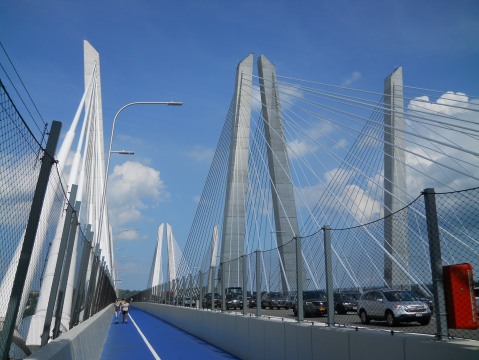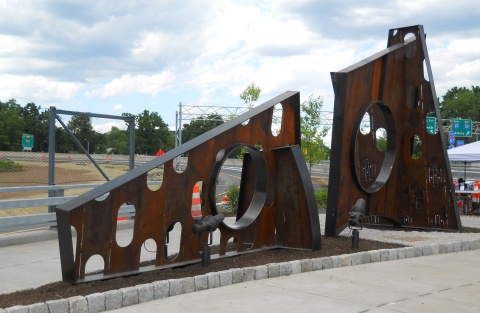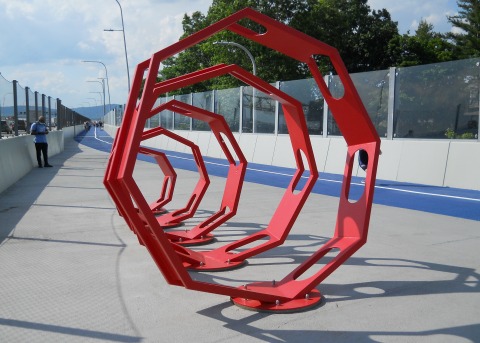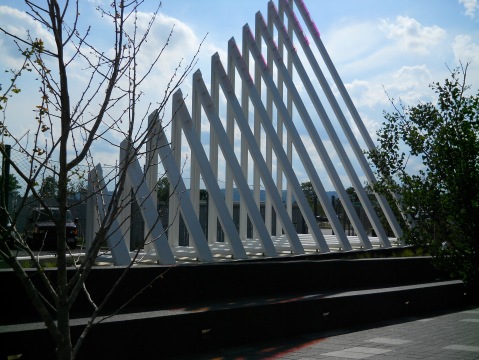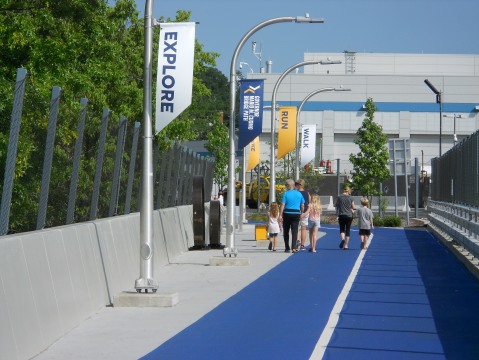Throwback Thursday: Last month I wrote an article about a controversial proposal in the state’s budget. As it was not published by the assigning editor, I’m posting it here. Thank you in appreciation to everyone who shared stories and submitted photos while hoping the proposal would be defeated. It was.
 Anticipating higher tolls and the ensuing hardship to their communities, Hudson Valley lawmakers and officials are fighting a proposal in Governor Andrew Cuomo’s $178 billion 2021 budget to merge the Bridge and Thruway Authorities.
Anticipating higher tolls and the ensuing hardship to their communities, Hudson Valley lawmakers and officials are fighting a proposal in Governor Andrew Cuomo’s $178 billion 2021 budget to merge the Bridge and Thruway Authorities.
With its 570 miles of roadways, 814 bridges, 118 interchanges, 11 toll barriers and 27 service areas, the New York State Thruway Authority collects approximately $800 million annually. In September 2018, the agency fully opened the $3.98 billion, twin-span Gov. Mario M. Cuomo Bridge (New NY Bridge project) that replaced the Tappan Zee Bridge between Westchester and Rockland Counties. The structure’s side path and six overlooks on its northern span, and landings in Tarrytown and South Nyack, will open this year.
Dissent and concern as deadline nears
“I strongly oppose this because it’s a solution in search of a problem,” Assemblymember Jonathan G. Jacobson (D-Newburgh) said. “There are no efficiencies to be gained as the New York State Bridge Authority is one of the most efficient agencies and has low tolls.”

Newburgh-Beacon Bridge/Photo credit Greg Herd
Worried eyes focus on the NYSBA’s Newburgh-Beacon Bridge, which subsidizes the other four — Rip Van Winkle, Kingston-Rhinecliff, Mid-Hudson and Bear Mountain Bridges — and carries I-84, taking in nearly half ($30 million) of NYSBA’s $62 million annual revenue.
“The governor can use it (Newburgh-Beacon) to get more money to pay for the Cuomo Bridge,” Jacobson said. Tolls on the other bridges would then increase, he said, “and that’s not fair. Around here, we cross the Hudson as often as some people travel Main Street. If you live in Highland you go to Poughkeepsie to shop, and if you live in Beacon and need a hospital, you go to St. Luke’s in Newburgh.”

Kingston-Rhinecliff Bridge/Photo credit Greg Herd
NYSBA is responsible for Walkway Over The Hudson Historic State Park, the 1.28-mile span between Poughkeepsie and Highland. It will not be impacted as it has a 99-year operating agreement with the Bridge Authority that runs through 2109 and will remain in force, Brian Nearing, Deputy Public Information Officer, NYC Office of Parks, Recreation & Historic Preservation, said.
Dutchess County Regional Chamber of Commerce President and CEO Frank Castella, Jr. can pick up the phone and voice a concern or a need to the Bridge Authority. “This is how a business-community partnership works,” he said. “We fear that relationship will disappear with the Thruway Authority, and we’ll start paying taxes without seeing where they’re spent.”

Mid-Hudson Bridge/Photo credit Greg Herd
A few years ago, the Chamber asked if it could fly the Special Olympics flag from the Mid-Hudson Bridge to honor the games being held in Poughkeepsie. “They said ‘yes’ and told us the dimensions of the flag,” Castella said. “It’s the first time a flag other than the American flag hung from that bridge.”
Emphasizing its economic drawbacks, Greene County Chamber of Commerce President / Executive Director Jeff Friedman said the Chamber also strongly opposes the merger and called it unnecessary. “Affordable tolls on the Rip Van Winkle Bridge are important,” he said. “They’re a lifeline for students attending Columbia Greene Community College and necessary for people going to the train station. And Columbia Memorial Hospital is across the river.”
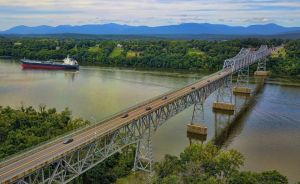
Rip Van Winkle Bridge/Photo credit Greg Herd
It’s a chance for the state to achieve some efficiency, Dave Friedfel at Citizens Budget Commission countered. “If something happens to one of those bridges, then traffic will shift to others within the system, and costs will be shared.”
“We already collaborate with the state to find savings on purchases,” Bridge Authority Chair Richard Gerentine said. “NYSBA is run by a Board of local volunteers who have always championed efficiency, maintenance, and safety.” None of the five bridges has ever been red-flagged during inspections.

Bear Mountain Bridge/Photo credit Greg Herd
Friedman noted the Bear Mountain Bridge is close to 100 years old yet the Tappan Zee was replaced after nearly 62 years. “We’re also concerned about safety and the fact that the Thruway Authority is deeply in debt due to (it) and needed DOT subsidizing.”
Assemblyman Kevin Cahill, D-Kingston introduced Bill A190 directing the Authorities to study how they can share services, combine functions and to determine the feasibility of merging that is in Assembly Committee. The Town of Newburgh passed a resolution opposing the merger; Ulster County adopted a similar resolution March 17.
Jacobson is confident the legislature will remove the proposal from the budget as “it will change everything in the Hudson Valley.”
Seeing educational opportunities
NYSBA partnership’s with Historic Bridges of the Hudson Valley was initiated in 2014 by former Authority Executive Director Joseph Ruggiero. This “small yet far-reaching not-for-profit educates the Hudson Valley and beyond about its amazing structures,” HBHV Executive Director Kathryn Burke said.

Master Teacher class at Bear Mountain Bridge
While the state and the governor talk about STEM (science, technology, engineering and math) education, Burke said, “HBHV makes a connection between STEM education and careers for educators and their students, and that is the missing piece in education today. Skills are taught, yet very few schools and educators are able to direct students to the vast variety of STEM careers.”
Arlington High School science teacher Steve Hertzog attended two HBHV-facilitated workshops for teachers last year that “provided a wonderful, panoramic view of the historical, technological, and socioeconomic impacts of the Hudson river bridges on the development of the Hudson Valley and its communities,” he said.

At Bear Mountain Bridge, NYSBA engineer explains tools
Hearing historical stories and feats of engineering, Hertzog said, “helps educators gain a better perspective on the impacts and opportunities that these bridges have provided and continue to provide for the Hudson Valley. When politicians cry out for rebuilding our nation’s ‘crumbling infrastructure,’ it doesn’t seem to apply to bridges north of the Cuomo Bridge.”
New York State Master Teacher Sunitha Howard brought her science classes at Yonkers Public Schools to the Bear Mountain Bridge to learn about STEAM.

NYSBA engineering intern Juan Cardenas with students
“Many of them have never been there before, and they’re fascinated by it,” Howard said. “We took them on a hike, and then went to the museum near the toll house,” where they heard from an engineering student, saw a 3D digital computer-aided design printing of the Bear Mountain Bridge, touched materials that were part of the bridge and saw where it was connected to the ground.
“It was a thrill for them,” she said. “These programs inspire the next generation of leaders in engineering and technology.”
Howard and Burke fear HBHV programs will be discontinued if the merger happens. The Thruway Authority declined to comment about the educational component.
* * * * *
When replacing the Tappan Zee Bridge became a reality, the NNYB project team saw building its replacement as an opportunity. Since 2013, more than 70,000 students learned about the project through an educational outreach program tailored to their grades and ages. Each year of the program correlated to each stage of building and construction.

Rebar sample is heavier than it looks/Photo credit NYSTA
They learned about the oyster relocation program and protecting endangered sturgeon and other aquatic life, and how the eight main span towers were built using jump forms. Kids touched samples of sheaths within the stay cables supporting the main span, held a piece of 18-gauge rebar (reinforcing steel bar) like that of the bridge’s invisible, interwoven support network and learned how engineers used building information modeling (BIM), a 3D model-based process.
“For four years we have worked with Andy O’Rourke, who has come to visit with our classes to discuss the STREAM (STEM plus research and art) ideas behind bridge-building,” Micki Lockwood, a 4th grade teacher at Claremont Elementary School in Ossining, said. “Students read about bridges, watched videos, designed bridges and had fun collaborating on low tech and high tech activities.”

Claremont School 4th grade/Photo credit Micki Lockwood
Lockwood described it as “an amazing opportunity to integrate our learning with a project that is happening right along our beautiful Hudson River.” When the pair of Peregrine falcons returned to the nest box atop one of the bridge’s towers each spring, there was a naming contest for the young hatchlings. Her students were excited the names they submitted — Puente and Rio — were chosen for two years.
“The NNYB project was an amazing resource for our studies,” she said. “My hope is that hearing the stories of the people who worked on the bridge will motivate our students to seek out careers in STREAM.”
Incremental toll hikes
The decade-long $5 cash ride from Rockland to Westchester ends this year. Cash tolls rise 30 percent to $6.83 in 2021 and $7.48 in 2022, plus a $2 monthly surcharge; E-ZPass® will be $5.25 in 2021 and $5.75 in 2022. The Board proposed a 40 percent commuter discount at the New York E-ZPass® rate and no increases for Westchester and Rockland residents through 2022. Changes await public comment.
NYSTA’s 2020 budget of $1.3 billion is $33 million or 2.4 percent less than 2019 and includes $72.4 million for the NNYB project, $371.7 million for operating expenses and $533.7 million for system-wide capital projects. Sections of roadway and a majority of its bridges date back to when the system opened in the 1950s, and need continual and significant repair and rebuilding.
NYSBA cash tolls become $1.75 in May, $2 in May 2022, and $2.15 in May 2023. E-ZPass® tolls, currently $1.25, incrementally increase $.10 annually from May 2020 to May 2023, when the rate will be $1.65. A public hearing was held March 9.
The Authority is proceeding to bid out for the Newburgh-Beacon Bridge’s north span redecking project, which is the largest project that will be funded through the toll revision, NYSBA spokesman Chris Steber said.
“Tolls are used for maintenance of spans, operations and debt service,” Steber said. “About 97% of the Authority’s revenue comes from tolls; the other 3 percent is from investment income, ad revenue on toll arms, and leasing dark fiber that goes over the bridge. This amounts to about $52.9 million in funds as of January 31, 2020.”
“The Authority believes strongly in preventive maintenance, and we do the best we can with the lowest possible toll rate,” he added. “Passenger cars pay less today than in the 1930s during the Depression, when drivers paid $1.60 roundtrip, plus an additional $.20 per passenger. That would be over $30 today with inflation.”
The NYSTA responded in a statement, “Both the Bridge and Thruway authorities operate with some of the lowest tolls in the nation, and that will remain unchanged with a merger as their revenue and how it is utilized will — and must be — invested to support their operations and capital programs.”
I’d like to know what you think.
Copyright © Janie Rosman and Kaleidoscope Eyes 2020
 Doubtful people will forget. This afternoon I walked on the spur path and the Esposito Trail and saw some people wearing masks, some weren’t, everyone was friendly, a few waved hello. A bicyclist who was behind me said “excuse me” so he could pass. More people were on the new path than were on the trail.
Doubtful people will forget. This afternoon I walked on the spur path and the Esposito Trail and saw some people wearing masks, some weren’t, everyone was friendly, a few waved hello. A bicyclist who was behind me said “excuse me” so he could pass. More people were on the new path than were on the trail. Another bicyclist stopped by the spur path entrance. “I wish this was open.” Both it and the entrance to new steps leading to Village Hall were blocked. “I think people using it will be respectful of each other,” he said when I mentioned the path is less than 12 feet wide. “I think we’ll all be careful.” The word YIELD was painted on the other side of the orange barriers, where the bridge and spur paths meet.
Another bicyclist stopped by the spur path entrance. “I wish this was open.” Both it and the entrance to new steps leading to Village Hall were blocked. “I think people using it will be respectful of each other,” he said when I mentioned the path is less than 12 feet wide. “I think we’ll all be careful.” The word YIELD was painted on the other side of the orange barriers, where the bridge and spur paths meet. Here is a closer view of both where they meet at the bridge path. If you click on the photo and again click on the tiny magnifying circle, then you can see them closely. Mom will not be able to see the art on the underpass walls because the spur path’s initial incline is too steep to safely navigate her wheelchair.
Here is a closer view of both where they meet at the bridge path. If you click on the photo and again click on the tiny magnifying circle, then you can see them closely. Mom will not be able to see the art on the underpass walls because the spur path’s initial incline is too steep to safely navigate her wheelchair. While the path’s overlooks, Welcome Centers and art placed along the way are nice touches, what would the original Tappan Zee Bridge builders think if they saw the new bridge and its tourist enticements? The design is modern, the new name removed history, and a neighborhood is forever changed again.
While the path’s overlooks, Welcome Centers and art placed along the way are nice touches, what would the original Tappan Zee Bridge builders think if they saw the new bridge and its tourist enticements? The design is modern, the new name removed history, and a neighborhood is forever changed again. Leave a comment
Leave a comment